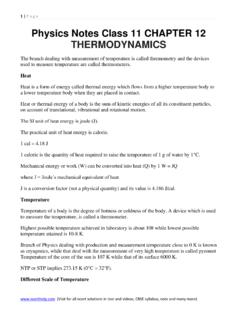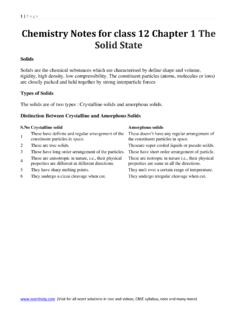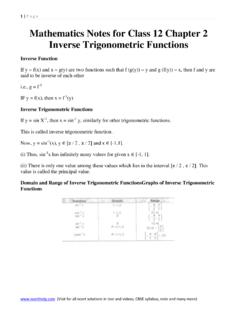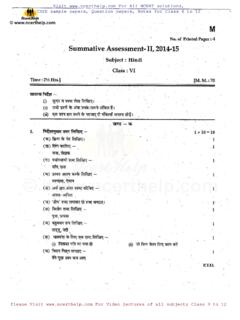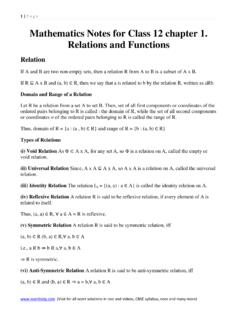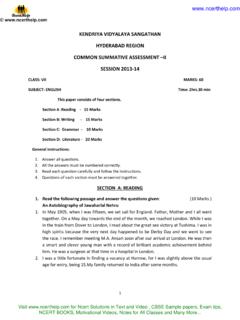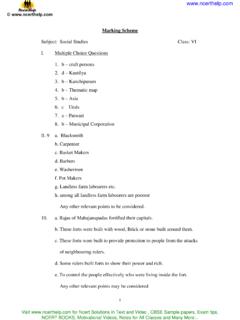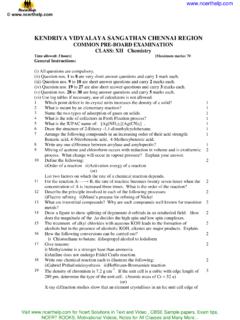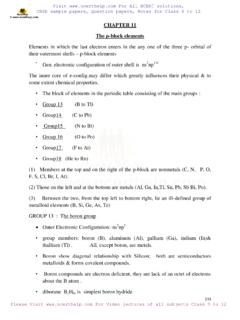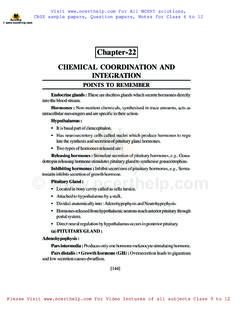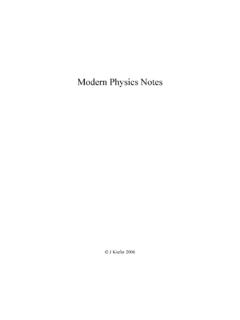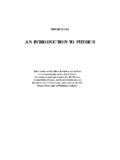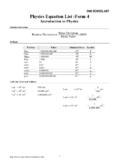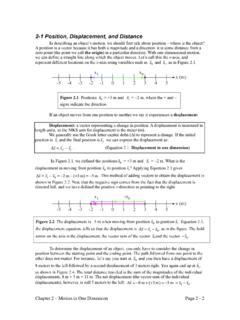Transcription of Physics Notes Class 11 CHAPTER 13 KINETIC THEORY
1 1 | P a g e (Visit for all ncert solutions in text and videos, CBSE syllabus, note and many more) Physics Notes Class 11 CHAPTER 13 KINETIC THEORY Assumptions of KINETIC THEORY of Gases 1. Every gas consists of extremely small particles known as molecules. The molecules of a given gas are all identical but are different from those of another gas. 2. The molecules of a gas are identical spherical, rigid and perfectly elastic point masses. 3. Their molecular size is negligible in comparison to intermolecular distance (10-9 m).
2 4. The speed of gas molecules lies between zero and infinity (very high speed). 5. The distance covered by the molecules between two successive collisions is known as free path and mean of all free path is known as mean free path. 6. The number of collision per unit volume in a gas remains constant. 7. No attractive or repulsive force acts between gas molecules. 8. Gravitational to extremely attraction among the molecules is ineffective due small masses and very high speed of molecules. Gas laws Assuming permanent gases to be ideal, through experiments, it was established that gases irrespective of their nature obey the following laws.
3 Boyle s Law At constant temperature the volume (V) of given mass of a gas is inversely proportional to its pressure (p), , V 1/p pV = constant For a given geas, p1V1 = p2V2 Charles Law At constant pressure the volume (V) of a given mass of gas is directly proportional to its absolute temperature (T), , 2 | P a g e (Visit for all ncert solutions in text and videos, CBSE syllabus, note and many more) V T V / T = constant For a given gas, V1/T1 = V2/T2 At constant pressure the volume (V) of a given mass of a gas increases or decreases by 1 of its volume at 0 C for each 1 C rise or fall in temperature.
4 Volume of the gas at t Ce Vt = V0 (1 + ) where V0 is the volume of gas at 0 C. Gay Lussacs or Regnault s Law At constant volume the pressure p of a given mass of gas is directly proportional to its absolute temperature T, , p T V/T = constant For a given gas, p1/T1 = p2/T2 At constant volume (V) the pressure p of a given mass of a gas increases or decreases by 1 of its pressure at 0 C for each l C rise or fall in temperature. Volume of the gas at t C, pt = p0 (1 + ) where P0 is the pressure of gas at 0 C. Avogadro s Law Avogadro stated that equal volume of all the gases under similar conditions of temperature and pressure contain equal number molecules.
5 This statement is called Avogadro s hypothesis. According Avogadro s law (i) Avogadro s number The number of molecules present in 1g mole of a gas is defined as Avogadro s number. NA = X 1023 per gram mole (ii) At STP or NTP (T = 273 K and p = 1 atm L of each gas has x 1023 molecules. (iii) One mole of any gas at STP occupies L of volume. Standard or Perfect Gas Equation 3 | P a g e (Visit for all ncert solutions in text and videos, CBSE syllabus, note and many more) Gases which obey all gas laws in all conditions of pressure and temperature are called perfect gases.)
6 Equation of perfect gas pV=nRT where p = pressure, V = volume, T = absolute temperature, R = universal gas constant and n = number of moles of a gas. Universal gas constant R = J mol-1K-1. Real Gases Real gases deviate slightly from ideal gas laws because Real gas molecules attract one another. Real gas molecules occupy a finite volume. Real or Van der Waal s Gas Equation (p + a/V2) (V b) = RT where a and b are called van der Waals constants. Pressure due to an ideal gas is given by p = (1/3).(mn/V). c2 = 1/3 c2 For one mole of an ideal gas P = (1/3).
7 (M/V).c2 where, m = mass of one molecule, n = number of molecules, V = volume of gas, c = (c12 + c22 + .. + cn2) / n allde root mean square (rrns) velocity of the gas molecules and M = molecular weight of the gas. If p is the pressure of the gas and E is the KINETIC energy per unit volume is E, then p = (2/3).E KINETIC Energy of a Gas (i) Average KINETIC energy of translation per molecule of a gas is given by E = (3/2) kt where k = Boltzmann s constant. (ii) Average KINETIC energy of translation per mole of a gas is given by 4 | P a g e (Visit for all ncert solutions in text and videos, CBSE syllabus, note and many more) E = (3/2) Rt where R = universal gas constant.
8 (iii) For a given gas KINETIC energy E T E1/E2 = T1/T2 (iv) Root mean square (rms) velocity of the gas molecules is given by (v) For a given gas c T (vi) For different gases c 1/ M (vii) Boltzmann s constant k = R/N where R is ideal gas constant and N = Avogadro number. Value of Boltzmann s constant is x 10-28 J/K. (viii) The average speed of molecules of a gas is given by (ix) The most probable speed of molecules of a gas is given by 5 | P a g e (Visit for all ncert solutions in text and videos, CBSE syllabus, note and many more) Degree of Freedom The degree of freedom for a dynamic system is the number of directions in which it can move freely or the number of coordinates required to describe completely the position and configuration of the system.
9 It is denoted by for N. Degree of freedom of a system is given by f or N = 3A R where A = number of particles in the system and R = number of independent relations. Degree of Freedom 1. For monoatomic gas = 3 2. For diatomic gas = 5 3. For non-linear triatomic gas = 6 4. For linear triatomic gas = 7 6 | P a g e (Visit for all ncert solutions in text and videos, CBSE syllabus, note and many more) Specific heat of a gas (a) At constant volume, CV = f/2 R (b) At constant pressure, cp = (f/2 + 1)R (c) Ratio of specific heats of a gas at constant pressure and at constant volume is given by = 1 + 2/f Mean Free Path The average distance travelled by a molecule between two successive collisions is called mean free path ( ).
10 Mean free path is given by = kT / 2 2p where = diameter of the molecule, p = pressure of the gas, T = temperature and k = Botlzmann s constant. Mean free path T and 1/p Brownian Motion The continuous random motion of the particles of microscopic size suspended in air or any liquid, is called Brownian of microscopic motion. Brownian suspended motion in both is observed with many liquids and gases. Brownian motion is due to the unequal bombardment of the suspended Particles by the molecules of the surrounding medium.
